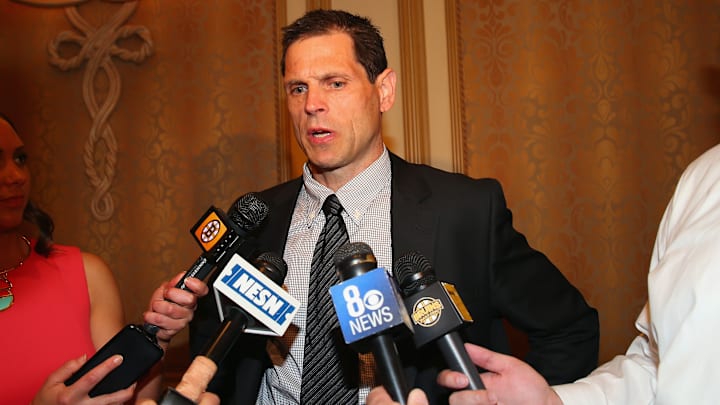The Boston Bruins’ 2015 NHL Draft – their first under general manager Don Sweeney – is one of the most infamous draft missteps in recent hockey history and continues to haunt the franchise a full decade later.
The Bruins had traded away Dougie Hamilton and Milan Lucic, setting themselves up for what should have been a terrific draft haul with three straight selections at Nos. 13, 14 and 15 overall. It was a deep draft class, too – widely considered one of the strongest in recent memory – with names like Connor McDavid, Jack Eichel, Mitch Marner and Mikko Rantanen headlining the top-10 selections.
The Bruins should have ended up with at least one cornerstone player. Instead, they ended up with Jakub Zboril, Jake DeBrusk and Zach Senyshyn. Of the three, only DeBrusk became an NHL regular – and even he requested a trade at one point.
Even more glaring was the amount of talent the Bruins passed on, with Mathew Barzal, Kyle Connor and Thomas Chabot coming off the board immediately after. Brock Boeser was picked later in the first round, and Sebastian Aho went early in the second. This was a whiff of epic proportions for the Bruins and one of the biggest draft blunders of the salary-cap era, especially for a team coming off a Stanley Cup window and in need of reinforcements.
Why the Bruins' 2015 NHL Draft blunder remains one of the biggest missteps in recent hockey history
There's a certain degree of luck involved in projecting the NHL potential of teenagers, but this wasn't bad luck for the Bruins. It was a massive, philosophical blind spot. Boston undervalued speed and skill in a draft that was overflowing with it and instead leaned too hard into the "Bruins Way" of scouting.
Zboril, selected at No. 13 overall, projected as a two-way defenseman, but injuries and inconsistency derailed his NHL career and forced him to play only sparingly as a depth piece. DeBrusk (No. 14) was easily the best of the three, but more of a middle-six winger than a franchise cornerstone. Senyshyn was widely considered a reach at No. 15 with a limited skillset, and he never became an NHL regular.
Meanwhile, Barzal (No. 16) went on to become a top-line center, a Calder Trophy winner and a franchise player for the New York Islanders. Connor (No. 17) became a perennial 30-40 goal scorer for the Winnipeg Jets. Chabot (No. 18) became a top-pair defenseman for the Ottawa Senators. Boeser (No. 23) became consistent top-six sniper for the Vancouver Canucks.
So, how did the Bruins whiff so hard (and so many times) in the 2015 NHL Draft? For starters, they prioritized size and “safe” profiles over elite skill. They projected Zboril and Senyshyn as NHL-ready bodies rather than betting on high-ceiling talent. Sweeney leaned into a “Bruins-style” mold that overvalued heavy, hard-working and overlooked dynamic skill players like Barzal and Connor.
The Bruins felt they needed to restock with defensemen and wingers after losing Hamilton and Lucic, which was particularly evident with their pick of Senyshyn. A major reach at No. 15 overall, the winger was graded by many scouts at the time as a late-first or second-rounder.
To be fair, there is an element of bad luck here, too. Even if Boston had made better bets, prospects still have uncertainty. Still, given the caliber of the players who were picked right after, the misses are glaring. After all, a single Barzal, Connor or Chabot pick could have reshaped Boston’s aging core transition.
In 2015, Boston was still drafting for “Big, Bad Bruins” hockey rather than embracing the league’s skill-and-speed trend. With three straight picks in the first round, the Bruins went for what they thought were safe, NHL-ready bodies instead of gambling on high-ceiling talent. For a first-year GM in Sweeney, playing it “safe” felt less risky than swinging for the fences.
Ultimately, the Bruins reached for organizational fits instead of drafting the best player available, and they got burned by passing on elite skill. The 2015 wasn't just bad luck for Boston; it was a philosophical blunder that continues to haunt the franchise to this day.
